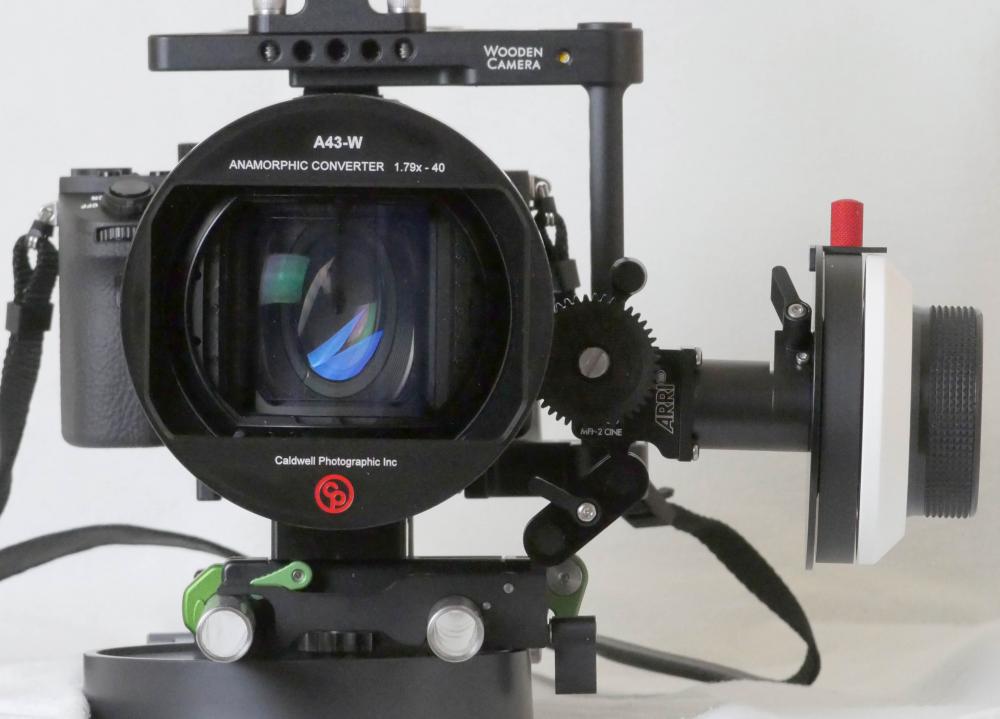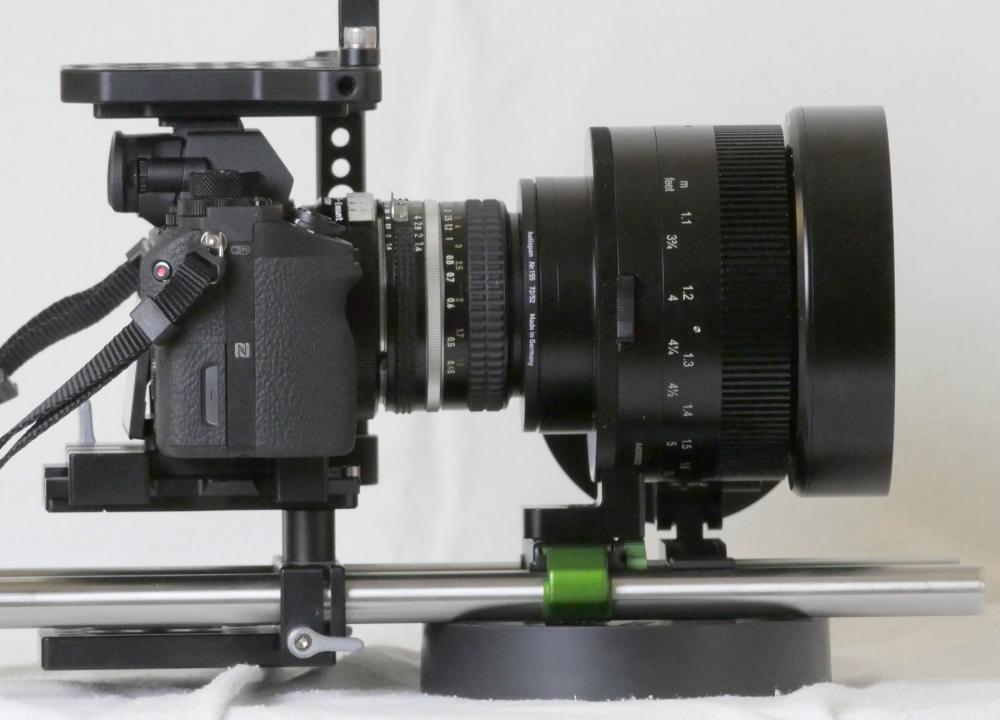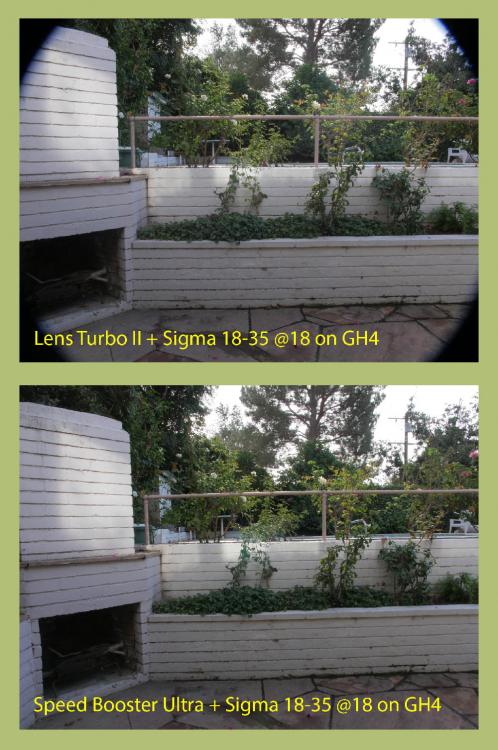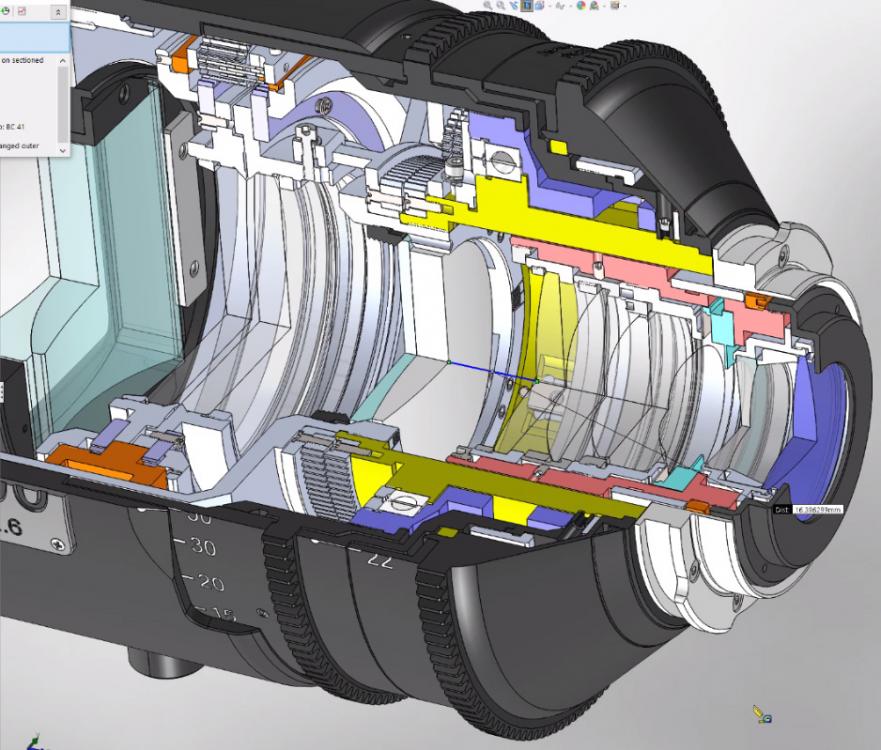
Brian Caldwell
-
Posts
153 -
Joined
-
Last visited
Content Type
Profiles
Forums
Articles
Posts posted by Brian Caldwell
-
-
17 hours ago, KnightsFan said:
Exactly. So my intuition was that a 17.5mm f0.95 on MFT would have roughly the same angle of incidence as a 35mm f2.0 on FF, thus making pixel vignetting a non-issue when comparing the two.
@Brian Caldwell has given me a few more things to read up on, thanks! Though, if I understand you correctly, the obliquity only darkens the edges of the bokeh, and will not have a large effect on the part that is in-focus?
Large marginal ray obliquity darkens the edges of bokeh circles.
Large chief ray obliquity in image space darkens the corners of the image.
Two very different but related effects.
-
On 5/18/2018 at 1:00 PM, KnightsFan said:
@horshack If I'm not mistaken, pixel vignetting is entirely due to angle of incidence on the sensor. Smaller sensors have less oblique angles of incidence at the corners. I could be wrong, but I bet that pixel vignetting won't be a factor in this comparison. I'd love to see evidence either way, though.
Oblique rays strike the center of the image as well as the corners. These are aperture dependent and are called marginal rays. The relationship between f-number and the marginal ray angle is given by f/# = sin(theta), where theta is the marginal ray angle. So, at f/1 the marginal ray angle is 30 degrees, and so on.
The obliquity of the marginal ray does cause a form of pixel vignetting that perhaps should be called pixel apodization. The effect is that the edges of bokeh blurs - where the marginal ray obliquity is highest - is darkened relative to the center. The good news is that this is the definition of "good bokeh".
I think Andrew's two sample images reveal this effect. I would guess that the bottom image was shot with the faster lens.
- noone, andrgl, EthanAlexander and 2 others
-
 5
5
-
I haven't carefully read every post in this thread, but everyone keeps incorrectly referring to the document in the first post as a "patent", when it is in fact only a published patent application. Patent applications aren't officially issued patents, and normally haven't even been reviewed by an examiner when they are published.
- foliovision, Matt James Smith ? and kye
-
 2
2
-
 1
1
-
23 minutes ago, Emanuel said:
Any idea when we''ll have your anamorphic prime series and the adapter to reach the streets? :-)
I'm assembling and adjusting the first 100mm prime right now. Samples of the 100mm and 32mm should be ready by the time Cine Gear rolls around. Another two (50mm and 150mm) hopefully by the end of the year. The "in-betweens", 40mm, 60mm, and 75mm will likely not appear until next year. I'm not sure about the adapter schedule yet.
-
11 hours ago, Julien416 said:
@Brian Caldwell From what I gathered online, seems the 4/3 anamorphic sensor area is exaclty the same as the GH5.
That's what I'm thinking, although GH5s in anamorphic 4k mode and GH5 in anamorphic 6k mode to be more exact?
10 hours ago, Andrew Reid said:Panasonic will soon(ish?!) send me a GH5S to play with so I’ll check it out.
Thanks Andrew!
-
- Popular Post
- Popular Post
7 hours ago, Cinegain said:Would love to see a Metabones single focus anamorphic adapter in one way or another. Veydra had looked into it, but weren't sure where Panasonic would go with the next gen sensor specs.
I've built prototypes of an iscorama-style single-focus adapter, but its really only suitable for shorter focal lengths in the 35mm to 75mm range. Also, its a bit large, and the front element moves during focusing, which may cause some issues with matte boxes. I'm also building a second type better suited for longer focal lengths in the 75 to 200mm range. I'm still debating whether to modify these for internal focusing, which would be good for heavy-duty cine use, but would make the adapters larger, heavier, and more expensive. To be honest, I've put the adapter project on hold until I get a few focal lengths in my anamorphic prime series completed.
- elgabogomez, Orangenz, Georgios and 8 others
-
 11
11
-
I'm trying to find out whether the Panasonic GH5s has an anamorphic movie mode that uses the full 17.3 x 13.0mm m43 format (21.6mm diagonal). Does anybody know? The actual format size for anamorphic shooting is critical to me.
Thanks!
-
Forgive me if this question has already been answered. Does the GH5s have a full-frame 4:3 anamorphic mode - i.e., with a full 21.6mm image diagonal? I know that 6k anamorphic is gone, but the maximum anamorphic image size is critical to me.
Thanks.
-
On 11/23/2017 at 1:41 AM, lmackreath said:
Ok received the Zhongyi lens turbo yesterday along with a normal nikon to m43 dumb adapter to use with the nikon sigma 18-35 with the GH5.
First impressions - No issues I can see at all with Vignetting and if it is there it is not noticeable, at the wide end with the Zhongyi which is around 13mm after conversion and it seems fine.
I'm curious if you are using a cropped mode on the GH5, because a quick test shows you get severe vignetting with the Lens Turbo II on full-sized m43 format when paired with the Sigma 18-35 at shorter focal length settings. This despite the fact that the Lens Turbo II has less reduction (0.726) than the Speed Booster (0.71)
On 11/13/2017 at 1:45 AM, anonim said:Slightly bigger crop factor of Zhongyi II is your friend
 It has crop factor lowering to 0.726 so you are pretty inside safe margin even with 18-35.
It has crop factor lowering to 0.726 so you are pretty inside safe margin even with 18-35.
Personally I used Zhongyi with GH2 witch has multiaspect ratio crop smaller than GH5 - of 1.86 - and there was no problem with full frame lenses, so you should no worry at all with Sigma Art full frame lenses.
BTW I found that Zhongyi has very little bit sharper reproduction than first version of Metabones speedboosters.
Even though the 18-35 has sufficient image circle diameter at 18mm to handle 0.71x focal reduction, the lesser 0.726x factor of the Lens Turbo II does not mean you are "inside safe margin". The issue here is that image circle diameter is only part of the story. Equally important is the exit pupil distance of the lens, and how well the focal reducer handles longer exit pupil distances. This is where the Lens Turbo II completely falls apart, because the 18-35 is nearly telecentric at the wide end, with an exit pupil distance of 150mm. My simple test above shows what happens: the vignetting with the Lens Turbo II is clearly caused by the focal reducer, and not the Sigma 18-35.
- Don Kotlos and jonpais
-
 2
2
-
1 hour ago, silvertonesx24 said:
I was referring to the anamorphic desqueeze monitoring option. I don't see a logical reason to only include one ratio, especially when all of the good lenses are different ratios.
Agreed about the de-squeeze options. If I were writing the monitor firmware I'd allow a continuous variation between 1.00x and 2.00x (at least to 0.01x resolution), and then show the resulting output rectangle ranging from 4:3 to 2.66:1. "Special" values like 1.33x, 1.5x, 1.79x, and 2x could be made available in a separate dumbed-down menu I suppose. I think the problem is that anamorphic is confusing to many people, and Panasonic has made some lowest common denominator assumptions about their customer base.
-
2 minutes ago, cantsin said:
Since I'm talking to the man... Would it be an option to design an anamorphic Speed Booster? If it's technically feasible, I'm sure people would go nuts over it...
The problem is that focal reducers naturally want to shrink the optical path, which is why a boosted lens is shorter than the same lens with a plain adapter. To do an anamorphic focal reducer you need to overcome this tendency, which is much easier said than done. Even if you succeeded and were able to produce an anamorphic focal reducer I don't think that people would go nuts over it. The reason is that it would be a rear anamorphic adapter, and therefore would not produce the horizontal flares, oval bokeh, and differential depth of field that are the main reasons why anamorphic is used nowadays. No doubt there would be a flurry of interest in the market, but then people would be spitting mad when they discovered that their newly created rear anamorphic lenses just do not look anamorphic. And then the mob with pitchforks and torches shows up at my house. No thanks!
-
2 hours ago, silvertonesx24 said:
Why would they do that. 1.5x and 2x is where it is at for anamorphic. 1.33x lenses are almost all crap.
The "why" seems pretty obvious. 16x9 is enormously important, and to get there from 4:3 without wasting sensor space you need (16/9)x(3/4)=1.33x. Whether or not 1.33x is "crap" or not depends entirely on the lens design.
-
On 9/2/2017 at 0:21 AM, jonpais said:
I know next to nothing about anamorphic, but am excited to try it. Are we to understand that you are designing a full frame lens that will require two adapters to mount it to the GH5? Also, will we be able to adjust focus with just one ring?
The base design is for Arri Alexa open gate, with a PL mount. I've intentionally made the BFL very long so that all lenses will be compatible with PL-EF adapters ( https://c7adapters.com/en/product/pl_lens_-_ef_mount/35 ). Due to the positive lock feature these adapters are completely rock steady and don't introduce any play that would be noticeable during focus pulls. So you basically have a choice of PL or EF by use of the adapter. With EF you can use COTS Speed Boosters to go down to M43 at very high speed. Alternatively, I may offer "native" M43 mount if the demand warrants it. Similarly I'll be able to produce "FF" and 65/70mm versions using the same base optics plus different rear optical groups. Either way, focus will be one-ring.
-
On 9/1/2017 at 11:41 PM, NewFilmMaker said:
The anamorphic mode is in 4:3, with a 1.5x lenses, it will come out as 2:1 , and if I am trying to de-squeeze it in to 2.39:1 or 2.66:1 , it means I need to crop the footage and it is going to lose resolution, am I right or wrong?
You're exactly right. Shooting with 2x lenses on 4:3 will give 2.66:1, which also requires cropping to get to the DCI standard 2.39:1 for normal theater projection. Which is why I'm interested in 1.79x lenses to yield 2.39:1 directly from 4:3 without any need for cropping.
-
49 minutes ago, NewFilmMaker said:
It sounds like the new anamorphic mode is only good for 1.33x and 2x anamorphic lens, anyone can share their ideas about the workflow for 1.5x lenses like iscorama & bolex anamorphot ?
If I understand correctly, the de-squeeze only applies to the viewfinder image. You can of course de-squeeze the actual footage to any value you want in post.
-
On 8/31/2017 at 3:10 AM, Andrew Reid said:
I will be putting a good word in for you with Panasonic
Hopefully they will do the extra stretch factors, we need 1.5x as well for Iscorama!
Awaiting the anamorphics Brian... To say I am looking forward to seeing what you come up with is an understatement

Hi Andrew: Any input you can give to Panasonic would be terrific - I really appreciate it! I'm really psyched about the GH5, and think it could become a really major anamorphic camera since the format is basically the same size as a 4:3 crop of Super 35.
Regarding anamorphic lenses, I'm currently working on primes, and they are mechanical beasts due to the Panavision-style counter-rotating Stokes lenses. So, I'm in the weeds worrying about screws, bearings, and special tools needed to manually pre-load a whole bunch of anti-backlash gears. One thing related to M43 and the GH5 is that they will be compatible with the M43 Ultra Speed Booster
 via high quality PL-to-EF adapters, which will create T/1.4 speed for all but the longest focal lengths.
via high quality PL-to-EF adapters, which will create T/1.4 speed for all but the longest focal lengths.
-
-
Glad to see a de-squeeze function, although 1.79x should be included since this is required to go from 4:3 to DCI 2.39:1 without cropping. Of course, I'm biased since I'm currently developing 1.79x lenses! Need to start lobbying Panasonic to add a few lines to their firmware . . .
-
Just a small correction to Andrew's article: All of the one-stop Speed Boosters sold by Metabones are 0.71x, not 0.74x. Note that a full stop is 1/(SQRT(2)) = 0.71.
-
10 hours ago, dhessel said:
Contrary to popular belief it appears that this is actually possible although I do not know what the maximum fstop acheivable would be. It is called a wide converter and was patented by kodak about two decades ago. We have never seen one since Kodak owns the patent and never produced one themselves.
Its a garbage patent. The fact that it expired several years ago - and hence is now in the public domain - and yet nobody has used the "technology" to produce anything should tell you something. The Kodak patent example is huge, slower than f/5, and basically doesn't work. The clue that something is seriously wrong is that the entrance pupil of the attachment - which must lie at the exit pupil of the attached lens - is tiny and located right next to the first surface of the adapter. This will result in severe vignetting with just about all lenses. I can't imagine that any prototype was ever made.
If you restricted yourself to telephoto lenses having an extremely long back focal length you *might* be able to design one that works, although US5499069 is non-enabling and you would have to invent something from scratch. The Kodak patent is completely useless if you want to make a general purpose focal reducer that will work with any SLR lens.
-
3 hours ago, Tim Sewell said:
I want a speedbooster that will let me use PL lenses on my iPhone.
Its not a Speed Booster, but the Artemis Prime directors viewfinder from Chemical Wedding does exactly what you want:
-
On 4/11/2017 at 10:52 AM, jcs said:
@tupp they're calling it large format and full frame in this press release, which I think is fair(-ish) relative to the industry standard Super35 http://www.panavision.com/panavision-announces-new-large-format-digital-camera:
They're pushing it a bit with the repetition of 'large format' when it's not even medium format (just a hair over full frame). Panavision gear is amazing and they have a wonderful history, it's unfortunate that marketing folks are driven to spin things in hopes of increasing sales, including doing equivalence tests wrong to demonstrate an advantage of one format over another as posted in a prior link.
Looks like a decent selection of FF lenses cover Red Weapon 8K / DXL, including some from Zeiss, Schneider, and Canon CN-E (a starter list from Phil Holland): http://www.reduser.net/forum/showthread.php?140564-RED-Weapon-8K-Lens-Coverage-Information
The Kipon FF MF is cool if will work with one's selection of MF lenses, though someone just posted some quality and compatibility issues in that old thread. FF seems to be the sweet spot right now for lens options- the standard for still photography for so many years.
The Panavision DXL is basically a re-housed Red Weapon 8k, and their new "70mm" lenses in fact cover just a bit larger than FF/Vistavision. A few years ago they were developing a larger format camera with a 48x20.25mm sensor (52mm diagonal) along with a separate set of lenses to go with it, but issues associated with the custom sensor doomed that project.
-
4 hours ago, Viscount Omega said:
Well, anyone could chime in, I don't care. I'm looking for a rebuttal or counter-argument against this explanation. (I didn't write it, btw. It's from a DP in another forum). Here, I'll copy/paste it again:
"Say you shot with a 24mm APS-C at f/4 and 36mm full-frame at f/6.3 both focused at 10 feet. The lenses / formats would produce a very similar horizontal and vertical field of view. The depth of field would also be very similar. Would these images be nearly identical? What would account for any differences?"
"The perspective will not be the same. The angles may match but your relationship (the cameras relationship) to the angle will not be the same. That is to say, if you picture a wedge representing your field of view, in the full-frame scenario you will be further inside of the wedge than in the APS-C format. In the APS-C format you will be closer to the 'point' of the wedge. Therefore the sense of peripheral vision will not be the same. Some would argue that this is why full-frame looks more natural or realistic than APS-C."Do the experiment properly and you'll find that the perspective is the same. Surely you must have heard countless times before that perspective depends only on the subject distance. This is a truth that you shouldn't ignore. More precisely, perspective depends on the distance from the subject to the entrance pupil of the lens. For this reason, the entrance pupil is sometimes called the center of perspective. I suppose you could call it the "point of the wedge" in your language. FYI, technically, the entrance pupil is the image of the aperture stop as seen from the front of the lens. So, in your experiment, just put the entrance pupil of both the 24mm and 36mm lenses at 10 feet from the subject, and the perspective will be precisely the same. There are some easy techniques for finding the entrance pupil location with an accuracy of about +/-1mm that stitched panorama shooters use all the time - if you need help just ask.
The subject-to-image plane distance is not what matters. Its the subject-to-entrance pupil distance that does. So, this notion that full frame will be "further inside of the wedge than in the APS-C format" is just another way of saying: "oops, I goofed, and didn't keep the subject distance constant".
-
17 hours ago, tupp said:
However, I do not think that a 80mm, MF lens with a 0.7x focal reducer would look the same as a FF, 56mm lens.
Well, the combination of an 80mm lens and a 0.7x focal reducer does have a focal length of 56mm. After all, focal reducers really do reduce focal length. You could prove this to yourself by measuring the separation of photographed stars or I could prove it to you in my lab using the nodal slide on my optical bench. And if you use that 56mm lens on FF (24x36mm) format, then *it is* a FF 56mm lens. In this case, the use of a focal reducer together with an 80mm lens is a perfectly valid way of designing and creating a true 56mm lens. As I mentioned in my earlier post, the only possible reason it will look different from any other 56mm lens will be due to lens/reducer aberrations and other flaws.





Difference between original Speed booster and the Ultra 0.71x
In: Cameras
Posted
The Ultra uses a significantly better optical design, with very high MTF and insignificant corner falloff. As a result, the Ultra will sharpen up any lens that is attached to it, including the Zeiss Otus series. Below is a very detailed MTF comparison of the original M43 Speed Booster, the Ultra, and the XL. The XL is also very sharp, but is a little more specialized than the Ultra.